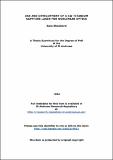Files in this item
Use and development of a CW titanium sapphire laser for nonlinear optics
Item metadata
| dc.contributor.advisor | Sinclair, B. D. (Bruce D.) | |
| dc.contributor.author | Shepherd, Sara | |
| dc.coverage.spatial | 159 p. | en_US |
| dc.date.accessioned | 2016-12-05T10:13:00Z | |
| dc.date.available | 2016-12-05T10:13:00Z | |
| dc.date.issued | 1994 | |
| dc.identifier.uri | https://hdl.handle.net/10023/9931 | |
| dc.description.abstract | A cw titanium sapphire laser pumped by an argon ion laser was used for experiments both in second harmonic generation using a non-linear crystal and for sum-frequency generation in an atomic vapour. In addition the laser was stabilised to sub-MHz levels. Using a crystal of potassium niobate (KNbO₃), the Ti:sapphire laser was frequency doubled over the range 860nm-905nm using an intracavity scheme. The crystal was temperature tuned to achieve near non-critical phase-matching and powers of up to 50mW were obtained, with a constant conversion efficiency per Watt over the doubling range. The thermal properties of potassium niobate in frequency doubling were examined and the effect of the crystal on the ring cavity during temperature tuning was investigated. The laser cavity was frequency stabilised using a 'side of fringe' locking scheme with a confocal Fabry-Perot etalon as the reference discriminator. The cavity length control elements were two Brewster-angled tilt plates and a piezo mounted mirror. Using this scheme the frequency noise was reduced from tens of MHz to 550kHz. Methods of obtaining a 30GHz frequency scan were also evaluated and an experimental 10GHz scan achieved. It was concluded that only dither and lock schemes are good enough to achieve reliable 30GHz scans. Using both a Ti:sapphire laser and a dye laser, two contrasting schemes for sum-frequency generation in sodium vapour were investigated, in which a magnetic field was used to break the symmetry of the medium. Using one of these resonantly enhanced routes, powers of 17μW in the UV were obtained from a classically 'forbidden' quadrupole transition. The effects of phase-matching on each of the transitions was examined in detail, and it was found that in general there are at least six factors which affect the phase-matching behaviour of the frequency mixing scheme. It was also found that on the route which had two sources of dispersion there was a significant distortion of the output line profiles at high temperatures due to a variation in phase-matching across the line profile itself. | en_US |
| dc.language.iso | en | en_US |
| dc.publisher | University of St Andrews | |
| dc.subject.lcc | TK7871.3T5S5 | |
| dc.subject.lcsh | Lasers | en |
| dc.title | Use and development of a CW titanium sapphire laser for nonlinear optics | en_US |
| dc.type | Thesis | en_US |
| dc.type.qualificationlevel | Doctoral | en_US |
| dc.type.qualificationname | PhD Doctor of Philosophy | en_US |
| dc.publisher.institution | The University of St Andrews | en_US |
This item appears in the following Collection(s)
Items in the St Andrews Research Repository are protected by copyright, with all rights reserved, unless otherwise indicated.

